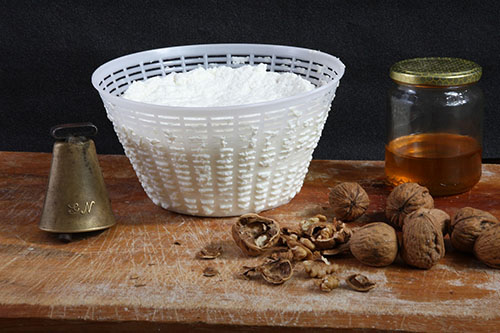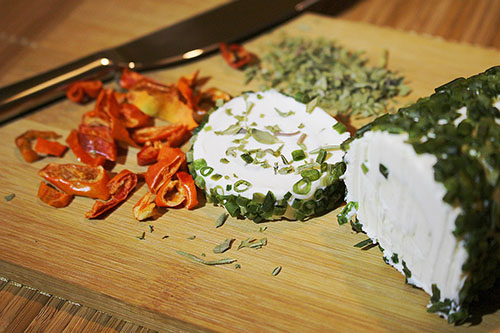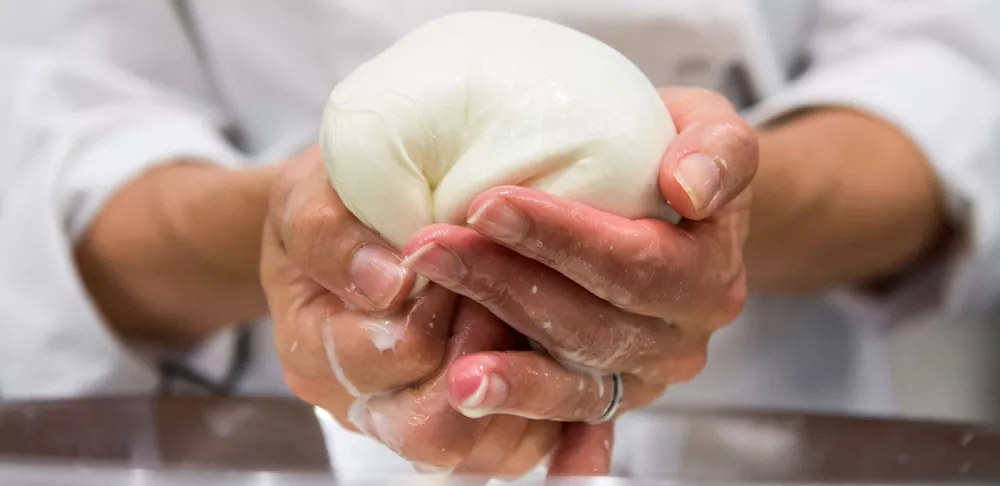Fresh cheeses go through only minimal transformation from milk to cheese, and experience little to no aging, leaving them with a high moisture content compared to other kinds of cheese.
Mostly milky or a little salty in flavor, fresh cheese can be made in a matter of hours, rather than weeks or months. Despite their inherent simplicity, however, fresh cheeses may be produced by various methods and treatments, which can produce a multitude of textures, from crumbly to stretchy to spreadable. The type of animal milk used, as well as any marinades or brines applied, can also govern fresh cheeses’ diverse flavors and textures.
Related Reading: 5 Major Cheese Styles Every Chef Should Know
Here we uncover what makes different types of fresh cheese unique, as well as explore various culinary applications for each.
Mozzarella
Mozzarella is arguably the most famous of the fresh cheeses and is typically made from either cow’s milk or buffalo milk, as in mozzarella di bufala. Inarguably, it is the best-selling cheese in the United States, largely due to our love of pizza. But simple mozzarella is more than meets the eye. Mozzarella’s signature attribute — its stretchiness and meltability — comes from the unique way that it is made.
Mozzarella is also known as a pasta filata, or “stretched curd” cheese. This stretching of the curd during formation is the step that creates mozzarella’s ability to stretch later on when heat is applied. Burrata, mozzarella’s cousin, is simply mozzarella stuffed with mozzarella scraps that have been dressed with cream, a mixture that is considered a fresh cheese unto itself, called stracciatella.
Mozzarella isn’t only limited to melty, pizza and pasta dishes with an Italian pedigree, however. Mozzarella is an excellent salad cheese, especially when it has a starring role like in caprese salad. It can be deep-fried, used as a stuffing, incorporated in egg dishes such as quiche and frittata and employed anywhere an excellent melting cheese is called for, such as grilled cheese or quesadillas.
To create mozzarella, fresh curds are melted together in a briny, hot water bath while they are pulled and shaped into the fresh balls we can easily find in almost any grocery store. (How hot is hot, you ask? I still have PTSD from making it in culinary school.) Mozzarella is typically made in a bath of about 180 degrees Fahrenheit. By comparison, the hottest hot tub tops out at about 110 degrees Fahrenheit. While it is readily available commercially, mozzarella is also an easy cheese to make yourself, either starting with fresh curds or making the curds from scratch from easy-to-get ingredients.
Try it Yourself: Hand-Pulled Mozzarella

Ricotta
Historically, ricotta may actually be considered a by-product of cheese, as it would have been developed from the liquid whey drained from making other types of cheese. This whey still contains minuscule milk solids, and another heating and acidifying of the whey creates micro-curds that are strained out of the liquid to form fluffy ricotta. Its name reflects its formation since it effectively goes through the heating and coagulation stage twice: ricotta means “re-cooked” in Italian.
Ricotta is potentially the easiest cheese to make from scratch, and fresh, house-made ricotta will always be superior to industrial, packaged ricotta. You can probably make it right now from the ingredients you have on hand. Some form of acid is required, such as lemon juice or white vinegar, and either cheesecloth or a mesh strainer.
Known mostly for its use in stuffed pasta dishes, ricotta can also be used to create creamy sauces and dips or to enrich the bases for goods such as pancakes, muffins or gnocchi.
Related Recipe: Pumpkin and Ricotta Gnocchi
Cream Cheese/Mascarpone/Quark
As cultured dairy products made by the separation of curds and whey, all of these fresh variations on “cream cheese” are in fact considered actual cheeses, and are governed by matters of process as well as fat and acid content. While ricotta is historically made from whey, cream cheeses are made with additional cream added to a milk base.
Their dense, homogeneous natures make cream cheeses ideal spreads, fillings and dips, but of course, they are also famous for being the stars of the show when it comes to cheesecakes or other custardy desserts. They can also create the frosting to top different types of cakes. For a savory application, I also find cream cheese and its ilk an excellent hack for creating quick and creamy stovetop macaroni and cheese.
Related Recipe: Tiramisu

Chèvre
While mozzarella may be the most famous of fresh cheeses, goats were domesticated before cows to produce food, meaning that fresh chèvre or something similar may be one of the oldest types of cheese. Fresh goat cheese also stands alone among fresh cheeses for having a very distinctive flavor, where farming practices really matter: keeping bucks separate from female goats while they are milking is necessary to avoid a funky, aggressively “goaty” taste. Otherwise, chèvre has a smooth consistency that can range from creamy to lightly chalky, and a flavor that is especially fresh and tangy.
Chèvre is extremely versatile and can be used for salads, deep-fried, baked into pastries and can also stand in for ricotta or cream cheese in a variety of spreads, dips and even cheesecakes. Fresh goat cheese is especially harmonious when paired with herbs.
Related Reading: Understanding Goat Cheese
Feta/Brined Cheese
Other forms of fresh cheeses, namely feta, may be kept in a water brine which both enhances their salty nature and increases the longevity of cheese, which is especially important for high-moisture fresh cheeses which otherwise have a typically short shelf life. Feta may be made from a number of different animal milks but is typically sheep and or goat, which both contribute to its strong, distinctive flavor.
Feta is known for being particularly crumbly and slightly drier in texture than other fresh cheeses, due to having a relatively large curd structure compared to other fresh cheeses. It can be pulverized into dips or spreads for a more homogenous consistency, but on its own, it also makes a beautiful addition to salads and Greek pastries. As it is not a superb melting cheese, feta can hold its form when grilled or baked. Also look for flavorful marinated feta options, where the cheese is stored in oil frequently flavored with garlic and herbs.
Related Recipe: Whipped Feta, Two Ways






